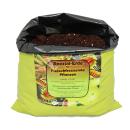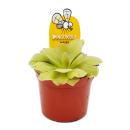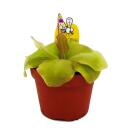Fatweed - Pinguicula agnata - 9cm pot
A natural flycatcher for fruit flies etc. Grease herbs especially rid your kitchen of these pesky critters.
Pinguicula agnata is special among the butterworts with its delicate white flowers that it forms in summer. The butterwort grows in the wild on steep limestone rocks next to cacti and succulents, so it is also very robust and easy to care for.
Pinguicula is heterophyllous, i.e. the plant produces different kinds of leaves: the typical sticky leaves with trap hairs in summer and thick-fleshed, smaller leaves without glandular hairs in winter.
In summer, Pinguicula agnata can reach up to 15 cm in diameter. If small offshoots form here, you can also divide the plant wonderfully so that you can oppose the annoying flies with a whole army of butterworts.
Pinguicula agnata always likes to be damp but not wet. In the winter months, this butterwort goes into a dry phase, during which it should be watered much less.
Pinguicula agnata is not winter-hardy and should be overwintered in a bright place at about 10 °C
.
Fatweed uses its fatty, sticky leaves to catch insects. The prey, mostly smaller insects, are attracted by the shine and scent of the catching organs (leaves). Once they have settled on the leaf, there is no escape. They stick tightly and are drained by digestive juices. The butterwort produces a large number of flowers that bloom for several weeks. There are about 70 species of butterwort worldwide.
Name: Fatweed
.
Botanical name: Pinguicula agnata
Pot size: 9cm
Native country: Mexico
Care:
The butterwort does not like it quite as wet as other carnivorous plants. It should be watered like a normal houseplant. A semi-shaded window spot is preferred. In direct sunshine, the butterwort can get sunburned.









